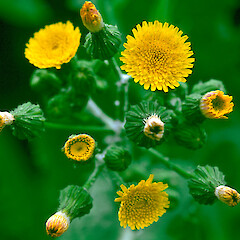Sonchus kirkii
Common name
puha, shore puha, New Zealand sow thistle
Synonyms
Sonchus asper var. littoralis Kirk, Sonchus littoralis (Kirk) Allan
Family
Asteraceae
Flora category
Vascular – Native
Endemic taxon
Yes
Endemic genus
No
Endemic family
No
Structural class
Herbs - Dicotyledonous composites
NVS code
The National Vegetation Survey (NVS) Databank is a physical archive and electronic databank containing records of over 94,000 vegetation survey plots - including data from over 19,000 permanent plots. NVS maintains a standard set of species code abbreviations that correspond to standard scientific plant names from the Ngä Tipu o Aotearoa - New Zealand Plants database.
SONKIR
Chromosome number
2n = 36
Current conservation status
The conservation status of all known New Zealand vascular plant taxa at the rank of species and below were reassessed in 2017 using the New Zealand Threat Classification System (NZTCS) – more information about this can be found on the NZTCS website. This report includes a statistical summary and brief notes on changes since 2012 and replaces all previous NZTCS lists for vascular plants.
Please note, threat classifications are often suggested by authors when publications fall between NZTCS assessment periods – an interim threat classification status has not been assessed by the NZTCS panel.
- Conservation status of New Zealand indigenous vascular plants, 2017 . 2018. Peter J. de Lange, Jeremy R. Rolfe, John W. Barkla, Shannel P. Courtney, Paul D. Champion, Leon R. Perrie, Sarah M. Beadel, Kerry A. Ford, Ilse Breitwieser, Ines Schönberger, Rowan Hindmarsh-Walls, Peter B. Heenan and Kate Ladley. Department of Conservation. Source: NZTCS and licensed by DOC for reuse under the Creative Commons Attribution 4.0 International licence.
2017 | At Risk – Declining
Previous conservation statuses
2012 | At Risk – Declining
2009 | At Risk – Relict
2004 | Gradual Decline
Distribution
Endemic. Three Kings, North, South, Stewart and Chatham Islands.
Habitat
Coastal. Usually on cliff faces in or around damp seepages where it often grows with the blue green alga Nostoc and fern Blechnum blechnoides. This species has a distinct preference for base rich rocks such as basalt, calcareous mudstones, siltstones, limestone or apatite-rich greywacke faces. On some offshore islands this species extends up into coastal scrub and herbfield. It occasionally grows on stabilised sand dunes. Indications are that this species once occupied a wider range of habitats but has retreated to those less suited to other faster growing introduced weeds.
Wetland plant indicator status rating
Information derived from the revised national wetland plant list prepared to assist councils in delineating and monitoring wetlands (Clarkson et al., 2021 Manaaki Whenua – Landcare Research Contract Report LC3975 for Hawke’s Bay Regional Council). The national plant list categorises plants by the extent to which they are found in wetlands and not ‘drylands’. The indicator status ratings are OBL (obligate wetland), FACW (facultative wetland), FAC (facultative), FACU (facultative upland), and UPL (obligate upland). If you have suggestions for the Wetland Indicator Status Rating, please contact: [Enable JavaScript to view protected content]
FAC: Facultative
Commonly occurs as either a hydrophyte or non-hydrophyte (non-wetlands).
Detailed description
Biennial to perennial herb (50-)150-600(-1000) mm tall. Taproot stout and swollen above. all parts exuding white latex when ruptured. Stem erect, simple or branched, finely grooved and ribbed, glabrous, hollow. Leaves thick, dull glaucous, lanceolate to narrowly oblong or linear oblanceolate (30-)80-200(-550) x (10-)30-60(-150) mm, margins dentate. Rosette and lower stem leaves pinnatifid to c.1/2 way to midrib; lobes broadly triangular, spreading or deflexed. Upper leaves not lobed, narrowly triangular to linear, or narrowly oblanceolate. Inflorescence cymose to umbellate. Capitula few to many. Involucre 10-15 mm , turbinate to cylindric, bracts imbricate, recurved at fruiting. Florets yellow. Achenes elliptic, brown, strongly flattened, (3-)4 x1-1.8 mm, 3-ribbed on each face, winged, wings and ribs smooth. Pappus hairs, fine, white.
Similar taxa
Easily distinguished from all the other naturalised Sonchus species by the very large, glaucous, non-spinose leaves.
Flowering
August - April
Flower colours
Yellow
Fruiting
September - June
Life cycle
Pappate cypselae are wind dispersed (Thorsen et al., 2009).
Propagation technique
Easy from fresh seed. Short-lived and best treated as an annual.
Threats
Appears to be declining over most of its range but especially in the North Island. The main threat seems to be from competition by faster growing weed species. Specifically there is some evidence that suggests it may be outcompeted by the introduced sowthistles Sonchus asper and S. oleraceus which grow faster, and thus can more quickly colonise the habitats preferred by S. kirkii. The species has also declined markedly along the south Wellington coast. Here it was once very common up until the mid 1980s subsequently it has disappeared from many of its former haunts, partly as a result of weed invasion and quarrying for rock, but it has also vanished from apparently stable, mainly indigenous habitats. The exact reason(s) for this loss are as yet unclear.
Etymology
sonchus: Sow thistle
kirkii: After Thomas Kirk (18 January 1828 - 8 March 1898), a NZ botanist and lecturer in natural sciences and regarded as a leader of botanical enquiry in NZ for over three decades. One of his most significant publications was Forest flora of NZ (1889) but he also contributed over 130 papers to the Transactions and Proceedings of the NZ Institute and other journals.
Further study
The relationship of this species to the Chatham Island endemic, monotypic genus Embergeria, and New Zealand endemic genus Kirkianella needs critical study.
Attribution
Fact sheet prepared by P.J. de Lange for NZPCN (1 June 2013)
References and further reading
Thorsen, M. J.; Dickinson, K. J. M.; Seddon, P. J. 2009. Seed dispersal systems in the New Zealand flora. Perspectives in Plant Ecology, Evolution and Systematics 11: 285-309
NZPCN Fact Sheet citation
Please cite as: de Lange, P.J. (Year at time of access): Sonchus kirkii Fact Sheet (content continuously updated). New Zealand Plant Conservation Network. https://www.nzpcn.org.nz/flora/species/sonchus-kirkii/ (Date website was queried)


















